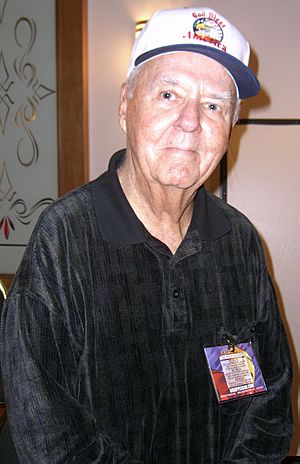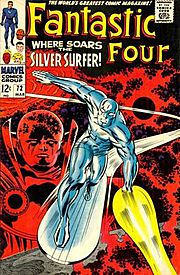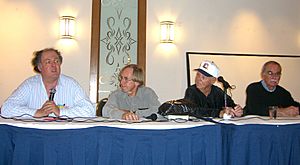Joe Sinnott facts for kids
Quick facts for kids Joe Sinnott |
|
|---|---|

Sinnott at the November 2008
Big Apple Con in Manhattan |
|
| Born | Joseph Leonard Sinnott October 16, 1926 Saugerties, New York, U.S. |
| Died | June 25, 2020 (aged 93) Saugerties, New York, U.S. |
| Nationality | American |
| Area(s) | Inker |
|
Notable works
|
Fantastic Four The Defenders The Avengers Thor |
| Awards |
|
| Spouse(s) |
Betty Kirlauski
(m. 1950; died 2006) |
| http://www.joesinnott.com/ | |
Joseph Leonard Sinnott (born October 16, 1926 – died June 25, 2020) was a famous American comic book artist. He was best known for his amazing work as an inker, especially on Marvel Comics' Fantastic Four. He worked on this comic from 1965 to 1981, often inking the drawings of the legendary Jack Kirby.
Joe Sinnott worked for Marvel for 60 years. He inked almost every major comic title, including The Avengers, The Defenders, and Thor.
Around the mid-2000s, Stan Lee, a co-creator of many Marvel characters, said that Joe Sinnott was the most wanted inker at the company. He joked that other artists would threaten him if Joe didn't ink their pages! Joe Sinnott's artwork even appeared on two U.S. Postal Service stamps in 2007. He continued to ink The Amazing Spider-Man Sunday comic strip until he retired in 2019.
Contents
Early Life and Comic Art Beginnings
Joseph Leonard Sinnott was born on October 16, 1926, in Saugerties, New York. He was one of seven children. Joe grew up in a house where many schoolteachers lived, and some of them inspired him to love drawing. As a child, he enjoyed comic strips like Terry and the Pirates and comic book heroes like Batman and Hawkman.
In 1944, after his brother Jack passed away while serving in the military, Joe joined the U.S. Navy. He served with the Seabees in Okinawa during World War II, driving a truck that carried supplies. He was honorably discharged in May 1946.
After the war, Joe worked in his father's cement factory for three years. Then, in 1949, he was accepted into the Cartoonists and Illustrators School in New York City. He was able to attend this school thanks to the GI Bill, which helped veterans pay for their education.
Joe's first professional art job on his own was a comic called "Trudi" in Mopsy #12 in 1950.
Learning from the Pros
One of Joe's teachers, Tom Gill, asked him to be his assistant. Joe helped Gill draw backgrounds and small details for comic books, especially Western-movie comics for Dell Comics. Joe said this was a great way to learn.
In 1951, Joe Sinnott met Stan Lee at Atlas Comics, which later became Marvel Comics. Stan Lee immediately gave him a script to draw. Joe drew many different types of stories for Atlas, including horror, science-fiction, and war-comics stories. He also drew Westerns and even some romance tales.
Joe lived in New York City for three years while attending art school. After that, he moved back to his hometown of Saugerties, New York, where he lived for the rest of his life.
Around 1957, Atlas Comics had less work for artists. Joe found other jobs during this time, like drawing for billboards and record covers. He also worked on Classics Illustrated comics and a Catholic-oriented comic book called Treasure Chest.
The Silver Age of Comic Books

The late 1950s and 1960s are known as the Silver Age of Comic Books. During this time, Joe Sinnott continued to draw for Atlas Comics as it slowly became Marvel Comics. He worked on titles like Strange Tales and Tales to Astonish. He also worked for Charlton Comics, drawing romance-comics stories.
Joe Sinnott's first time working with Jack Kirby, one of the most important creators in comics history, was on a war-comics story in 1960. He then inked several of Kirby's giant-monster stories.
His first Marvel superhero comic was The Fantastic Four #5 (July 1962). This issue was very important because it introduced the famous supervillain Dr. Doom. Joe also inked the first appearance of the Norse god superhero Thor in Journey into Mystery #83 (August 1962).
In 1965, Joe Sinnott returned to Marvel to work almost exclusively for them. He began his long and famous time on Fantastic Four with issue #44 (November 1965). He stayed on the series even after Jack Kirby left, continuing until 1981. During this time, he helped bring to life many iconic characters like Galactus, the Silver Surfer, the Black Panther, and the Inhumans.
During the Silver Age, Joe also inked several Captain America stories and the "The Inhumans" backup feature in Thor. He also worked on the first issue of The Silver Surfer in 1968.
Later Career and Retirement

Throughout his many years as an artist for Marvel, Joe Sinnott inked almost every major comic title. He had notable runs on The Avengers, The Defenders, and Thor.
Joe Sinnott retired from drawing comic books in 1992. After that, he focused on inking The Amazing Spider-Man Sunday strip and creating new versions of classic comic covers. He still contributed to Marvel occasionally, even inking a special cover for Captain America in 2011.
He finally retired from the Amazing Spider-Man strip in March 2019, when he was 92 years old.
Personal Life
In August 1950, Joe Sinnott married Elizabeth "Betty" Kirlauski. They were married for 56 years until Betty passed away in 2006. They had four children: two sons, Joseph Jr. and Mark, and two daughters, Kathleen and Linda.
Joe Sinnott passed away on June 25, 2020, at the age of 93. His grandson said that Joe enjoyed life and was still drawing right up until the end.
Awards and Special Recognition
Joe Sinnott received many awards for his amazing work in comics:
- 1995 Inkpot Award
- 2008 Inkwell Hall of Fame Award
- 2008 Inkwell Award for Favorite Inker (tied with Terry Austin)
- 2008 Inkwell Awards Special Ambassador
- 2013 Will Eisner Hall of Fame Award
There is even an award named after him, called the "Joe Sinnott Hall of Fame Award," given by the Inkwell Awards.
Legacy in Comics
Two images drawn by Jack Kirby and inked by Joe Sinnott are featured on "Marvel Super Heroes" commemorative stamps. These stamps were released by the U.S. Postal Service on July 27, 2007, and show the Thing and the Silver Surfer.
Joe Sinnott is considered the number one inker in American comics by historians at Atlas Comics in Chicago, Illinois.
See also
 In Spanish: Joe Sinnott para niños
In Spanish: Joe Sinnott para niños

